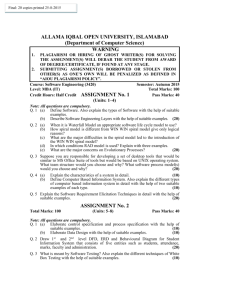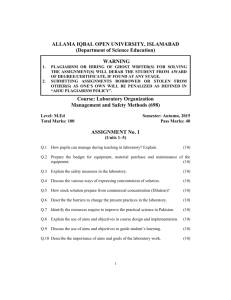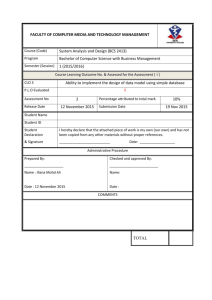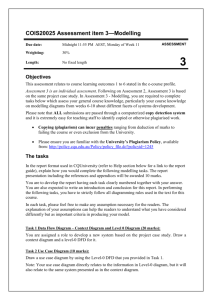- Allama Iqbal Open University
advertisement
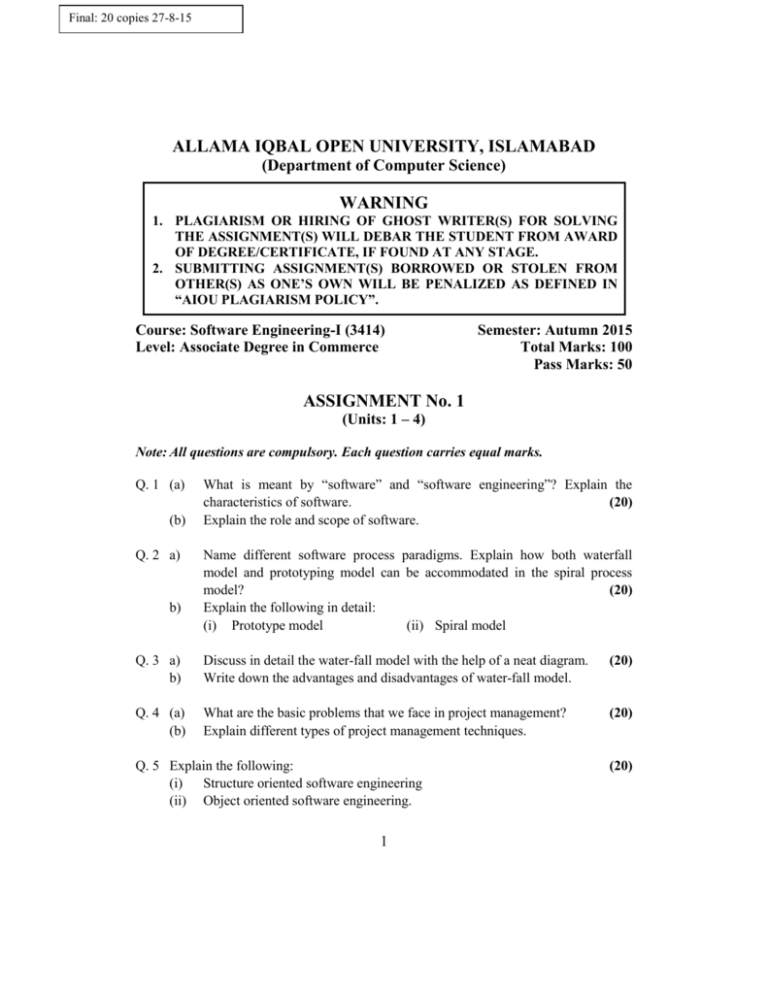
Final: 20 copies 27-8-15 ALLAMA IQBAL OPEN UNIVERSITY, ISLAMABAD (Department of Computer Science) WARNING 1. PLAGIARISM OR HIRING OF GHOST WRITER(S) FOR SOLVING THE ASSIGNMENT(S) WILL DEBAR THE STUDENT FROM AWARD OF DEGREE/CERTIFICATE, IF FOUND AT ANY STAGE. 2. SUBMITTING ASSIGNMENT(S) BORROWED OR STOLEN FROM OTHER(S) AS ONE’S OWN WILL BE PENALIZED AS DEFINED IN “AIOU PLAGIARISM POLICY”. Course: Software Engineering-I (3414) Level: Associate Degree in Commerce Semester: Autumn 2015 Total Marks: 100 Pass Marks: 50 ASSIGNMENT No. 1 (Units: 1 – 4) Note: All questions are compulsory. Each question carries equal marks. Q. 1 (a) (b) Q. 2 a) b) What is meant by “software” and “software engineering”? Explain the characteristics of software. (20) Explain the role and scope of software. Name different software process paradigms. Explain how both waterfall model and prototyping model can be accommodated in the spiral process model? (20) Explain the following in detail: (i) Prototype model (ii) Spiral model Q. 3 a) b) Discuss in detail the water-fall model with the help of a neat diagram. Write down the advantages and disadvantages of water-fall model. (20) Q. 4 (a) (b) What are the basic problems that we face in project management? Explain different types of project management techniques. (20) Q. 5 Explain the following: (i) Structure oriented software engineering (ii) Object oriented software engineering. 1 (20) ASSIGNMENT No. 2 (Units: 5 – 9) Total Marks: 100 Pass Marks: 50 Q. 1 (a) (b) Explain in detail requirement engineering tasks. What are the important characteristics that requirements must preserve? And how requirements can be managed? (20) Explain the following elements of system models: (i) Scenario based elements (ii) Behavioral elements Q. 2 (a) (b) Discuss in detail the data modeling activity. (20) Write briefly about the utility of state transition diagram in analysis modeling activity. Q. 3 (a) (b) Draw a detailed DFD for the library information system. What is ER diagram? Discuss its usage in data modeling. (20) Q. 4 (a) (b) What are the characteristics and criteria for design? Explain the following design concepts. (i) Modularity (ii) Abstraction (20) Q. 5 Write short notes on: (a) Basic path testing (b) Black box testing (c) White box testing (d) System testing (20) 2 3414 Software Engineering-I Credit Hours: 4 (4+0) Recommended Book: Software Engineering 5th Edition by Roger Pressman Course Outlines: Unit No. 1 Introduction Introduction to Software, role of Software, Characteristics of Software, Need for Software, Introduction to Software Engineering Unit No. 2 Software Engineering Models Software Process, Software Process Models (Linear Sequential Model, Prototyping Model, RAD Model, Evolutionary Software Process Models) Unit No. 3 Project Management Project Management Concept, Software Management Team, Common Software Management Problems, and Basic Management Techniques Unit No. 4 System Engineering System, Types of system, elements of system, Approaches to Software Engineering (Structured approach, Object-Oriented approach) Unit No. 5 Analysis Concepts and Principles Requirements Analysis, Communication Techniques, Analysis Principles, Software Prototyping, Specification, Specification Review Unit No. 6 Analysis Modeling-I Elements of the Analysis Model, Data Modeling, Functional Modeling (DFD), Behavioral Modeling (STD) Unit No.7 Analysis Modeling-II Entity Relationship Diagram (ERD), Control Flow Model, Control Specification and Process Specification, the Data Dictionary Unit No. 8 Design Concepts and Principles Design concepts, Design Process, Effective Modular Design, Design Principles for Effective Modularity, and Introduction to Design Model Unit No. 9 Software Testing Methods Software Testing Fundamentals, Testing objectives, Testing Principles, Test Case Design, white Box Testing, Basis Path Testing, Control Structure Testing, Control Structure Testing, Black Box Testing 3
